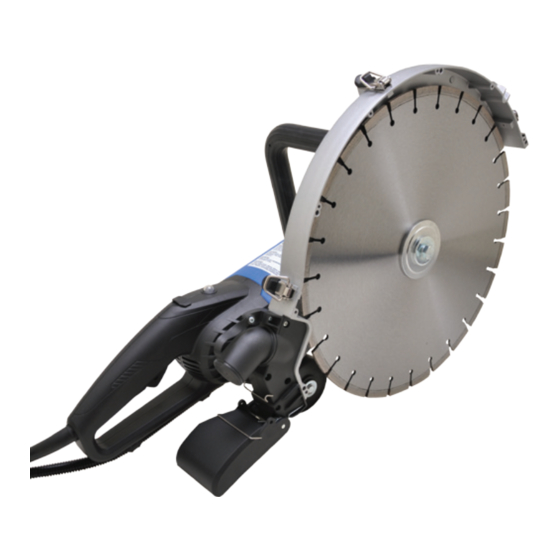DIAQUIP QHS-400 운영자 매뉴얼 - 페이지 11
{카테고리_이름} DIAQUIP QHS-400에 대한 운영자 매뉴얼을 온라인으로 검색하거나 PDF를 다운로드하세요. DIAQUIP QHS-400 18 페이지. Electric handsaw

ADJUSTING THE BLADE GUARD
The blade rotates clockwise when viewed from the arbor end. Therefore, most of the cutting
debris, sparks and slurry is thrown to the rear. So the blade guard should be adjusted so that
the rear edge is flush with the workpiece.
TO ADJUST
First pull out the locking lever against the spring
tension, then rotate the blade guard to the desired
position. Allow the locking lever to engage the
nearest slot in the guard to lock it into position.
BLADE GUARD BRUSH
There is a removable brush at the rear of the guard to help contain sparks, dust, debris and
slurry. To install, simply push the brush into the slot in the bottom of the dust port bracket until it
clicks in place. This brush may be pulled straight out to replace when worn.
SPLASH GUARD
The spring-loaded splash guard is useful to help to contain slurry which splashes toward the
back. To install, simply clip into place on the back of the dust port bracket. To remove, tilt
upward to pop free. If the splash guard is not needed, such as when cutting dry, it may be
clipped up out of the way. Simply engage the male clip on the flap with the female clip on the
mount. Unclip to release.
/20
Blade Guard Locking Lever
WWW.DIAQUIP.CO.UK
WATER CONNECTION
Water is a basic requirement for diamond sawing with
wet-type diamond blades. The water serves as a coolant to
avoid the working surface of the diamond segments from
overheating. When the diamond bit becomes overheated,
both the bond matrix and even the diamonds break down,
thus destroying the blade. Besides cooling, water also
keeps down dust and flushes away abrasive particles.
WARNING: Always ensure a PRCD (GFCI) is used
when operating with water
WARNING: Never allow water to enter the motor. It could lead to an electric shock.
WARNING: Check all connections of the water feed system to ensure there are no leaks.
Inspect hoses and other critical parts which could deteriorate.
WARNING: The maximum water pressure should not exceed 70 psi (4bar).
Use a water collector with a wet vacuum to collect cooling water if nearby objects could be
damaged by water. The water feed system is built into the machine. To connect with the water
supply, first pull the quick-release collar to remove the female side of the water coupling. Then
unscrew the nut and engage the coupling to the water hose. Now reconnect the water coupling
to the male water feed valve. Press it until it clicks. The water flow is controlled by the water
feed valve. The water to the blade may be finely adjusted to the required amount and no more.
NOTE: Contaminants in the water supply can easily plug up the fine water nozzles in the
blade guard. Ensure that the supply water is clean. If you find that there is no water flow
to the blade, then clean out the water feed system on the machine.
GUIDE ROLLER ASSEMBLY
The guide rollers make it easier to keep the blade plane
perpendicular to the workpiece. To install, slacken the butterfly
bolt slightly and engage the four claws with the four eyelets
on the bottom of the motor housing, then tighten the butterfly
bolt. Note that roller assembly is offset to one side to avoid
contacting the blade, so it may only be installed in one
orientation. If it is not needed, the guide roller assembly may
be removed and set aside.
WWW.DIAQUIP.CO.UK
Open
Closed
Water Feed Valve
Butterfly Bolt
/21
